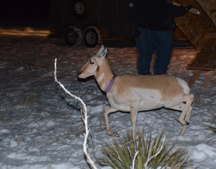Wildlife crossings are expensive. They can add hundreds of thousands of dollars to a highway renovation project — and that’s the cheapest option for creating them. However, a new study from Utah State University has found that by preventing expensive vehicle accidents, wildlife passages pay for themselves in three years.
An article in the Deseret News described the research and the findings.
The way the math works is this, according to the article: wildlife collisions cost an average of $7,000. Collisions were reduced by 90 percent by the passages in the study.
Read the report itself, here. (You can also go to the UDOT website and search for “Report UT-12.07”)**
Read the Deseret News article here.
**Thanks to Susan, a subscriber, who knew where this was even though I couldn’t find it.

 At Trapper’s Point in Wyoming, migrating pronghorns and mule deer are funneled by two rivers to 13-mile stretch of Highway 191, where they attempt to cross. Each year they endanger their own lives crossing the highway, and human lives as well,
At Trapper’s Point in Wyoming, migrating pronghorns and mule deer are funneled by two rivers to 13-mile stretch of Highway 191, where they attempt to cross. Each year they endanger their own lives crossing the highway, and human lives as well,